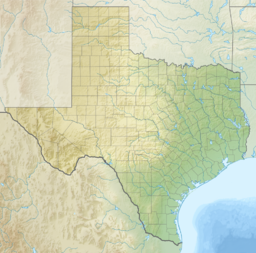| Lake Tyler | |
|---|---|
| Lake Tyler East/West | |
 View of Lake Tyler East from a Park on State Highway 64 | |
| Location | Smith County, Texas, United States |
| Coordinates | 32°12′40″N 95°10′28″W / 32.21111°N 95.17444°W |
| Type | reservoir |
| Primary inflows | Caney Creek |
| Primary outflows | Prairie and Mud Creeks |
| Built | 1949 (West) and 1966 (East) |
| Surface area | 4,714 acres (1,908 ha) |
| Average depth | 17.6 ft (5.4 m) |
| Max. depth | 40 ft (12 m) |
| Surface elevation | 375 ft (114 m) [1] |

Lake Tyler (West) is a man-made public water reservoir located south-east of Tyler, Texas, in eastern Smith County. While named after the town of Tyler (pop. 104,789), Lake Tyler is closer to the smaller cities of Whitehouse (pop. 7660) and Arp (pop. 970). Lake Tyler resides in the northern Neches River watershed,[2] and was formed after the completion of Whitehouse Dam on Prairie Creek in 1949.[3] The design engineer of the dam was T.C. Forrest (Now Forrest and Cotton, Inc.), and the earthfill dam was constructed to be 4,708 feet long, standing at a maximum height of 50 feet, with a width of 20 feet and a drainage area of 48 square miles, according to the Texas Water Development Board. Lake Tyler is found in the Piney Woods ecoregion of eastern Texas, a temperate coniferous forest hosting a great amount of biodiversity. Just to the east of the lake lies Lake Tyler East, created after the completion of Mud Creek Dam in early 1967.[4] Just over a year later, in May 1968, the two lakes were connected by a canal to combine the water supply.[5] Together, the two lakes have a combined safe yield of over 30 million gallons per day,[6] and combine to encompass an approximate surface area of 4,714 acres, all maintained and operated by the city of Tyler to provide a source of public water to several surrounding communities.[7]
- ^ "Lake Tyler (Neches River Basin)". Texas Water Development Board. Retrieved 2022-11-04.
- ^ "Introduction to the Texas Clean Rivers Program - Angelina & Neches River Authority". www.anra.org. Retrieved 2021-11-29.
- ^ "Lake Tyler (Neches River Basin) | Texas Water Development Board". www.twdb.texas.gov. Retrieved 2021-11-28.
- ^ ushist. "USHistory Research Blog". USHistory Research Blog. Retrieved 2021-11-29.
- ^ "Lake Tyler (Neches River Basin) | Texas Water Development Board". www.twdb.texas.gov. Retrieved 2021-11-29.
- ^ "Lake Tyler/Lake Tyler East | Tyler, TX". www.cityoftyler.org. Retrieved 2021-11-29.
- ^ "Lake Tyler (Neches River Basin) | Texas Water Development Board". www.twdb.texas.gov. Retrieved 2021-11-29.


